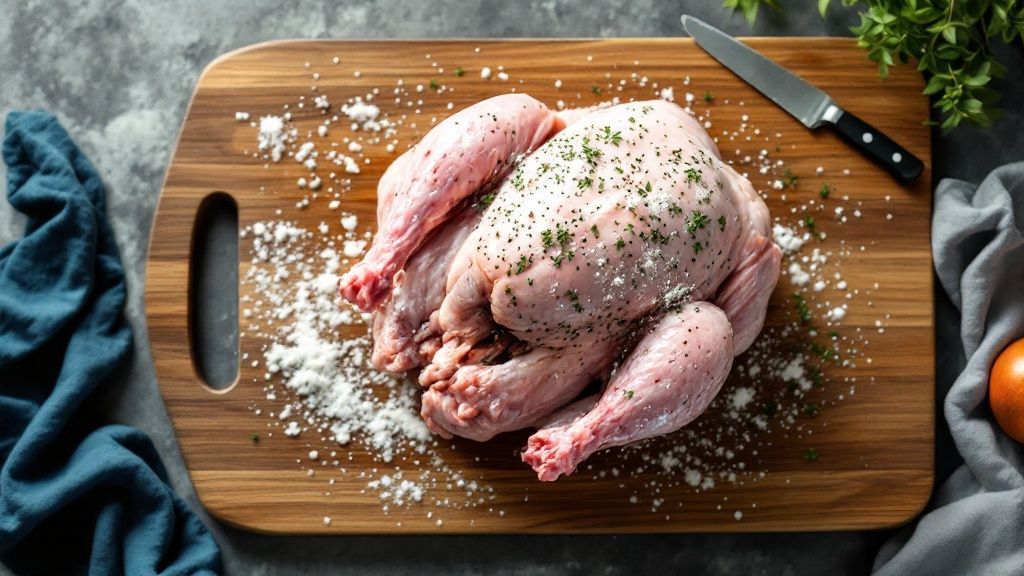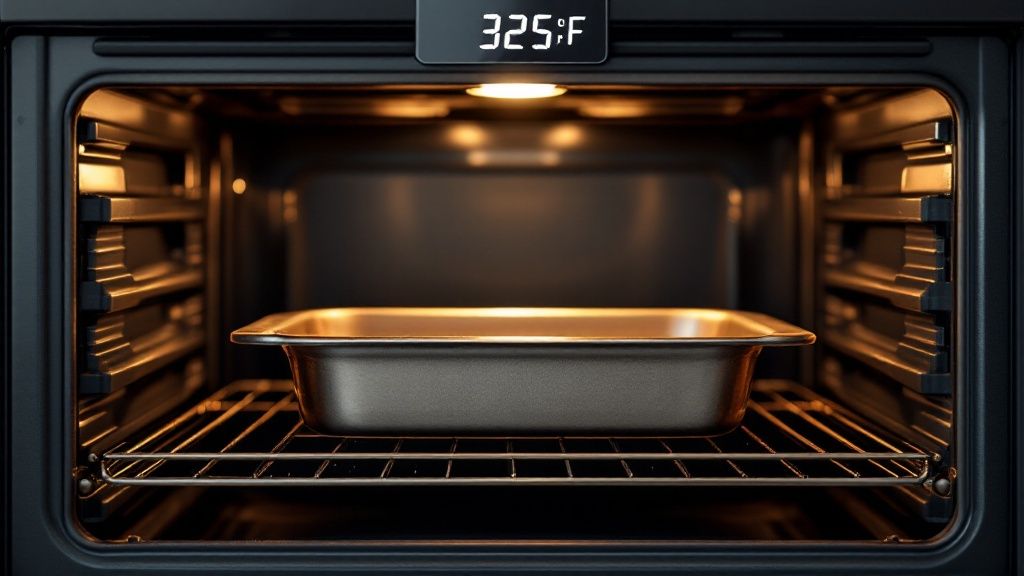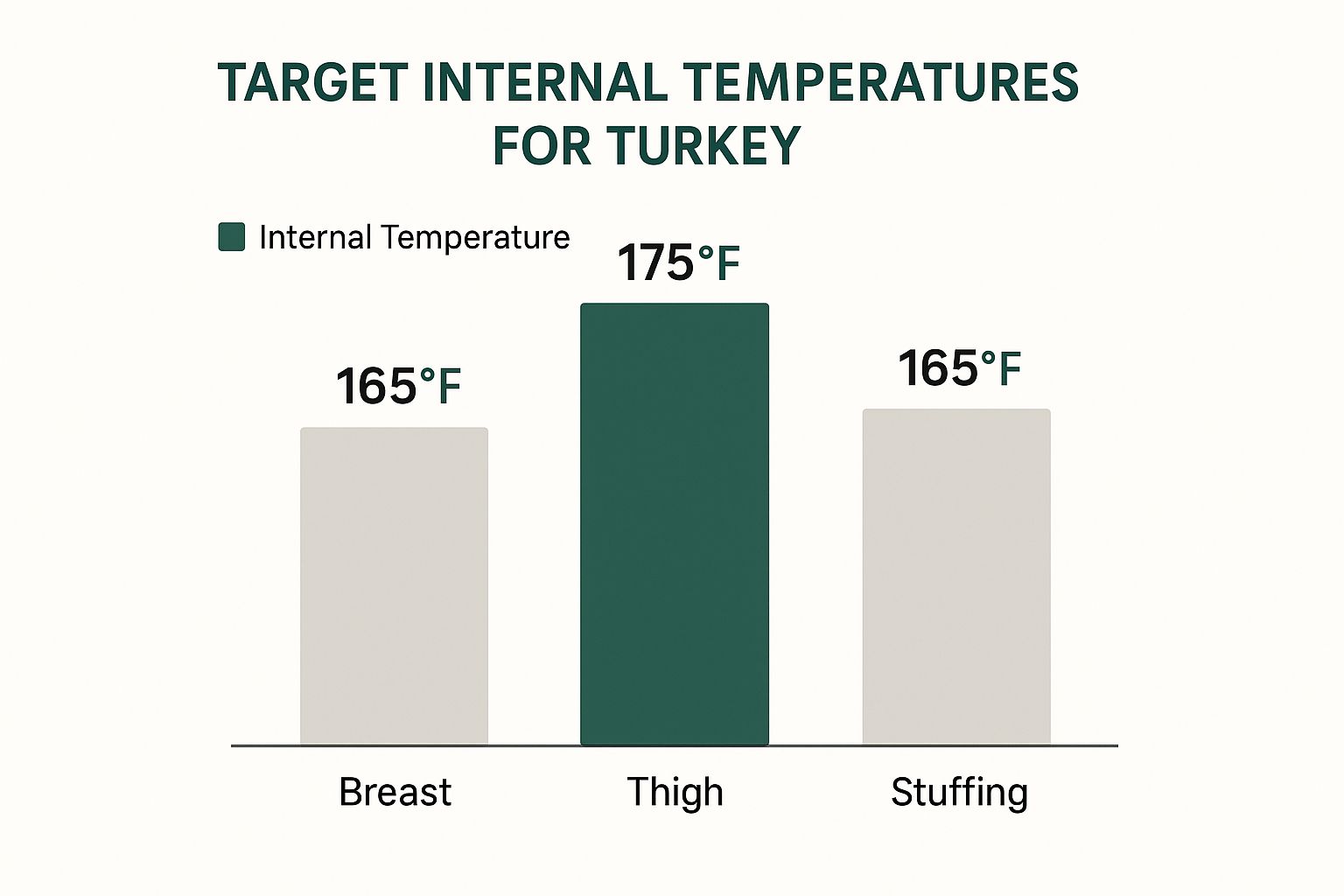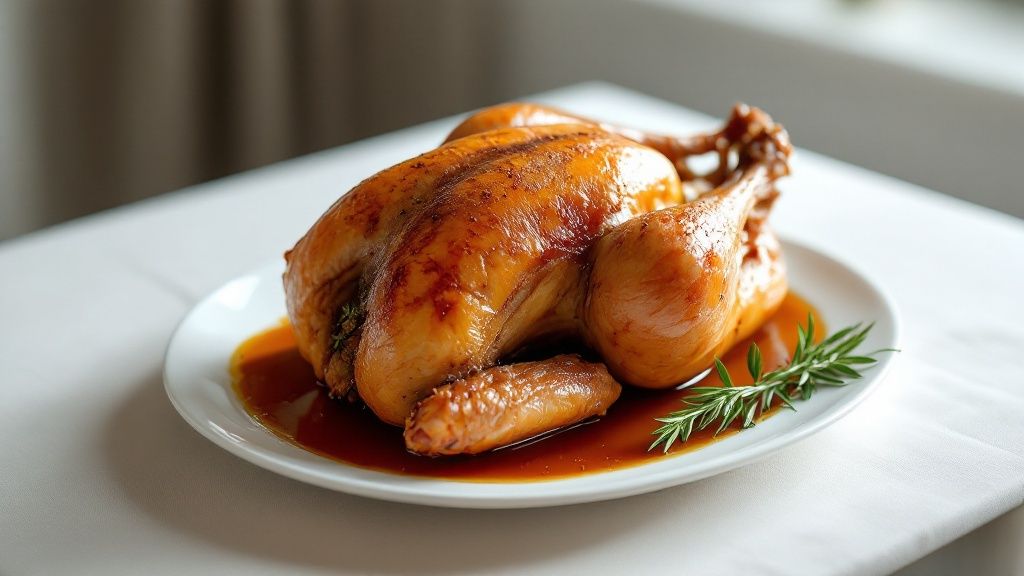Correct Temperature for Turkey A Chef’s Guide
Let’s cut to the chase. If there’s one number you need to remember for a perfect Thanksgiving, it’s 165°F (74°C).
This isn’t just a suggestion from a chef—it’s the science-backed temperature that guarantees your turkey is safe to eat and free from nasty bacteria. Hitting this target is the absolute key to a delicious, worry-free holiday feast.
The Foundation Of A Perfectly Cooked Turkey

Think of 165°F as the “safety lock” for your meal. Getting the right temperature isn’t just about avoiding a dry, disappointing bird; it’s a non-negotiable food safety rule. Everything else we’ll discuss builds on this one foundational fact.
There’s a good reason government health agencies are so strict about this. According to Health Canada’s safe cooking temperatures guidance, all poultry has to reach an internal temperature of at least 74°C (165°F) to wipe out dangerous bacteria like Salmonella and Campylobacter. It’s a simple step that has been proven to dramatically reduce the risk of foodborne illness.
Once you master this single temperature, you’re already on your way to becoming a more confident holiday cook. It completely removes the guesswork and lets you focus on what really matters: enjoying the day with family and friends.
We’re going to cover everything you need to know, including:
- Why 165°F is the universal gold standard for turkey safety.
- How to correctly measure the temperature in different parts of the bird (because they don’t all cook the same!).
- The absolutely crucial role of resting your turkey after it comes out of the oven.
Why 165 Degrees Is the Gold Standard for Safety
You’ve probably heard the number 165°F (74°C) thrown around so much it feels like a culinary commandment. But where did that number come from, and why is it the non-negotiable benchmark for cooking a safe turkey? It all boils down to the science of pasteurization—a fancy word for hitting a temperature that kills harmful bacteria almost instantly.
Think of nasty bugs like Salmonella and Campylobacter as tiny invaders hiding in the meat. They simply can’t survive extreme heat. While you could kill them at a lower temperature, you’d have to hold the meat there for a very specific, extended period. That requires precise equipment most of us don’t have in our home kitchens. When you’re juggling a dozen other dishes, simple and safe is the way to go.
The Instant-Kill Temperature
Hitting an internal temperature of 165°F is your foolproof guarantee. At that exact point, the destruction of dangerous pathogens is so fast it’s considered immediate. No timers, no complicated charts—just pure, simple food safety. It’s the culinary equivalent of a powerful, one-and-done cleaning solution for your turkey.
This approach gives you a critical safety margin, protecting your family and friends from any risk of foodborne illness. The goal isn’t just to memorize a rule, but to understand why it works. That knowledge gives you the confidence to serve a Thanksgiving meal that’s both mouth-watering and undeniably safe.
The USDA recommends cooking all poultry, including turkey, to a minimum internal temperature of 165°F (74°C) as measured with a food thermometer. This ensures that potentially harmful bacteria are killed, making the meat safe to eat.
Why Poultry Is Different
So, why are we so obsessed with temperature when it comes to chicken and turkey? Poultry is uniquely susceptible to contamination. Bacteria like Salmonella often live in the digestive tracts of birds and can easily get transferred to the meat during processing.
Unlike a good steak, which you can safely enjoy rare because bacteria typically stay on the surface, pathogens in poultry can be present all the way through the meat. This is why cooking a turkey to the right temperature isn’t just a suggestion—it’s an absolute must for food safety. By ensuring even the thickest parts of the bird reach 165°F, you’re making sure every single bite is safe to enjoy.
How to Properly Use a Meat Thermometer

Simply owning a meat thermometer doesn’t guarantee a perfectly cooked turkey—using it correctly is what separates the pros from the home cooks. So many holiday meals have been compromised by simple mistakes in placement and timing, leading to readings that are way off the mark.
Think of your thermometer as a surgeon’s scalpel. It’s a precision tool. To get a truly accurate reading, you have to know exactly where to measure. The entire goal is to find the absolute coldest part of the bird, because if that spot is done, you know the whole turkey is safely cooked. This is why your technique matters just as much as the tool itself.
Where to Check the Turkey Temperature
Forget poking it just anywhere. There are two spots that matter most: the thickest part of the breast and the innermost part of the thigh. These are the last areas to cook through, so they are your fail-safe checkpoints.
Here’s how to nail it every time:
- Check the Thigh: Gently guide the thermometer deep into the chunkiest part of the thigh, but be careful not to hit bone. The thigh bone runs parallel to the body, so you want to aim for that dense, meaty area right alongside it. Bone conducts heat differently than meat, so touching it will give you a false high reading and a potentially undercooked bird.
- Check the Breast: Now, move to the breast. Insert the probe horizontally into the thickest part, once again steering clear of any bone.
One of the most common mistakes is not inserting the thermometer deep enough. For an accurate reading on the correct temperature for turkey, the tip of that probe has to be in the thermal center—the dead middle of the thickest section of meat.
It’s shocking how often this gets overlooked. A 2019 study found that only 31.5% of people actually cooked their turkey to the recommended 165°F (74°C), with incorrect thermometer placement being a huge culprit. Want to sharpen your skills beyond the holiday bird? Our guide on the top cooking tips for chefs is packed with techniques to refine your kitchen instincts.
Navigating the Breast vs. Thigh Temperature Dilemma
Here we are, at the classic Thanksgiving showdown: the lean, delicate breast meat versus the rich, hard-working dark meat of the thighs. It’s a temperature tug-of-war that happens right inside your oven. The breast cooks much faster, leaving you with a tough choice. Pull the turkey out when the breast is perfect? You risk undercooked thighs. Wait for the thighs to finish? You’re left with a dry, chalky breast.
This isn’t a sign of a bad cook—it’s just turkey biology. The breast is all tender, lean muscle that cooks in a flash. The thighs, on the other hand, are packed with connective tissue and fat that need more time and higher heat to break down and become succulent. So, while the USDA says the entire bird is safe once it hits 165°F, aiming for that single number everywhere is a surefire way to sacrifice flavor and texture.
Aiming for Perfection, Not Just Safety
For the best possible turkey, you need to treat it like it has two separate cooking goals. The breast is at its absolute peak of juiciness right at 165°F. Any higher, and it starts to dry out. The dark meat in the thighs, however, truly shines when it reaches a higher temperature, ideally around 175°F. That extra heat is what melts all that tough connective tissue into rich, flavorful gelatin.
This is the secret to a bird that’s juicy and tender all over.

To help you nail this, here’s a quick guide comparing the minimum safe temperature with the ideal temperature for the best eating experience.
Optimal Doneness Temperatures for Turkey Parts
| Turkey Part | Minimum Safe Temperature | Ideal Doneness Temperature (Flavor & Texture) |
|---|---|---|
| Breast | 165°F (74°C) | 165°F (74°C) |
| Thigh | 165°F (74°C) | 175°F (79°C) |
| Stuffing | 165°F (74°C) | 165°F (74°C) |
As you can see, letting the thigh temperature climb higher than the breast is the key. You’re not just cooking to a safe temperature; you’re cooking for incredible texture.
So, how do you manage this temperature gap? One great trick is to give the thighs a head start. Try placing an ice pack over the breast for about 30 minutes before the bird goes into the oven. This chills the white meat down, so it has more catching up to do. Another simple but effective technique is to shield the breast with a small piece of aluminum foil about halfway through cooking. This slows its roll while the thighs keep climbing toward that magic 175°F mark.
Mastering this balance is what separates a good turkey from a great one.
The Unskippable Step: Resting Your Turkey

You’ve done it. You pulled a perfectly golden-brown turkey from the oven, and the aroma is filling your entire kitchen. The temptation to grab a knife and start carving is almost overwhelming.
But wait. This is where patience truly becomes a virtue. Resting your turkey isn’t just an old wives’ tale; it’s a non-negotiable step that separates a decent bird from a spectacular one. It’s the secret to making sure every single slice is dripping with juicy flavor.
Imagine the muscle fibers in your turkey are like tightly wound springs after their long, hot workout in the oven. If you slice into it right away, all those precious juices will flood out onto the cutting board, leaving you with dry, disappointing meat. Resting allows those fibers to relax and reabsorb all that moisture, locking it in place.
Let Carryover Cooking Do Its Magic
While your turkey is resting, a fascinating bit of food science is happening. It’s called carryover cooking. The intense heat trapped deep inside the bird continues to radiate outwards, actually causing the internal temperature to keep climbing.
You can expect the temperature to rise by another 5 to 10 degrees Fahrenheit during this time. This is why we pull the turkey out a little early! By taking it out of the oven when the breast hits 165°F, carryover cooking ensures it reaches its final, perfectly safe temperature on the counter—without a hint of being overcooked.
The science of carryover cooking is your best friend for a moist, flavorful turkey. This simple act of patience is the final step to guaranteeing a perfect result every single time.
The Right Way to Rest Your Turkey
Resting is easy, but doing it right makes all the difference. Here’s how:
- Get it Off the Heat: Transfer your turkey from the blazing hot roasting pan to a carving board. Leaving it in the pan will cause the bottom to keep cooking and get tough.
- Tent it Loosely: Drape a piece of aluminum foil over the turkey like a tent. You don’t want to wrap it tightly—that would trap steam and make your crispy skin soggy. A loose tent keeps it warm while letting the skin breathe.
- Be Patient: This is the hard part. Let it rest for a minimum of 20-30 minutes. For a larger bird, waiting up to 40 minutes is even better.
This crucial waiting period gives the juices time to redistribute throughout the meat, guaranteeing that every slice you carve is tender, moist, and packed with flavor. Trust me, it’s worth the wait.
When You Might Hear Different Temperature Advice
You’ve probably got it memorized by now: 165°F is the magic number for a perfectly safe turkey. It’s the universal, non-negotiable standard from the USDA. So what do you do when you see a recipe from a fancy chef or a high-end farm suggesting a much lower temperature?
Don’t panic—it’s not a mistake. It’s an exception that proves the rule, and it almost always applies to highly specialized, artisan birds that are worlds away from what you find at the local grocery store.
Think of it like this: the turkey you buy at the supermarket is like a reliable family sedan. It’s built for safety and consistency. An artisan, dry-aged bird is more like a high-performance sports car—it operates under a different set of rules due to its unique engineering. These producers might use special diets, a dry-aging process, or cultivate unique fat marbling that completely changes how the meat cooks.
The Niche Producer Exception
A great example of this is the artisan producer KellyBronze. They famously advise cooking their free-range birds to just 140°F (60°C), then letting it rest for a full 30 minutes. During that rest, carryover cooking works its magic, bringing the final temperature up to a safe 149°F (65°C).
They can recommend this because their specific rearing and dry-aging methods create a bird with a totally different composition.
CRITICAL: This advice is only for their specific product. It should NEVER be applied to a standard turkey from your grocery store. For the bird you’re bringing home for the holidays, 165°F is the only benchmark that guarantees safety.
These niche cases are fascinating from a culinary perspective, but they don’t change the fundamental rules of food safety for the rest of us. If you’re planning a special holiday meal and want to ensure everything is perfect without the guesswork, you might love the idea of celebrating the holidays in Atlanta with a private chef.
Common Turkey Questions We Hear All the Time
We’ve walked through the big stuff, but on the big day, there are always a few last-minute questions that pop up right when things get hectic. Here are a few quick answers from our chefs to keep you on track.
My Turkey Is Done Way Too Early—Now What?
First off, don’t panic! This is a super common scenario. If your bird hits that magic 165°F mark well before your guests arrive, you’ve got an easy fix.
Pull it from the oven and let it rest for at least 30 minutes, just like you normally would. Then, go ahead and carve the meat off the bone and arrange it in an oven-safe dish. Pour a little chicken broth over the slices to keep them moist, cover the dish tightly with foil, and pop it into a warm oven set between 150-200°F. It’ll stay perfectly warm and juicy until you’re ready to serve.
Here’s a pro tip: Don’t freak out if you see a little pink in the meat, especially with a smoked or grilled turkey. That pinkish color often comes from gases that set the color in the meat’s myoglobin. As long as your thermometer reads 165°F, you’re golden. Trust your thermometer, not just your eyes.
Ready to elevate your next event from a simple meal to a memorable culinary experience? Let Culinary Collective Atl handle the details. Discover our personalized private chef services at https://www.theculinarycollectiveatl.com.





